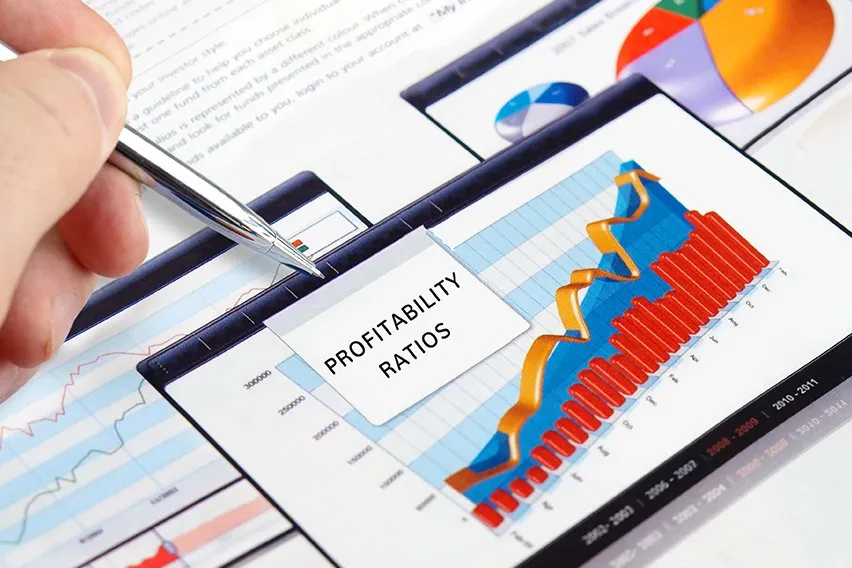Profitability Ratios: Definition & Types

What current processes do you have in place to track the success of your business? There are several different financial metrics and financial ratios that you can use. And one of the most effective ways to measure your success is using profitability ratios.
You might already know what profitability ratios are if you have been in business for a while already. Yet, if you’re still in the earlier stages of your business venture then you might not know the different types of profitability ratios.
Understanding what contributes to business profitability can be a challenging task. And this can be for anyone, whether you have been in business for years, you’re a start-up or an entrepreneur.
That said, profitability ratios are an important element when it comes to potential investors or lenders. So, what exactly do you need to know about profitability ratios? Let’s take a closer look.
Here’s What We’ll Cover:
What Are Profitability Ratios?
What Are Profitability Ratios?
There are several financial metrics and calculations that you can use to determine how successful your business is. Profitability ratios are one of those financial metrics. And they’re used to evaluate business performance based on things like revenue, operating costs and your balance sheet. Plus, it provides insights into investors’ equity within a specified accounting period.
It shows how efficient your business is when it comes to utilizing your assets to generate income. There’s no sense in operating a business if you aren’t going to turn a profit. Profitability ratios can get compared to those from a previous quarter. Or against competitors within your industry.
The higher the profitability ratio compared to past data might mean that your business performed well in that period. This is because it shows you are generating revenue, cash flow and profits.

Types of Profitability Ratios
There are two different categories when it comes to profitability ratios and how to analyze financials. They are margin ratios and return ratios. And by using these two types, you can get a better picture of the financial health of your business and its performance.
Plus, margin and return ratios help both you and potential investors answer business questions.
- Is the performance of your business getting better or worse over time?
- Where does your business stand in regards to generating income?
- Are there any areas where your business can improve to perform better?
- How does your business stack up compared to the competition?
Let’s take a closer look at how margin ratios work.
Margin Ratios
The role of margin ratios is to measure how efficiently your business is turning sales into profits. It shows insights into how well you’re handling everything from an increase in sales to other financial areas. Margin ratios can further get broken into three categories.
Gross Profit Margin (GPM) Ratio
The gross profit margin is often one of the first financial metrics that a business will use to help analyze its sales. It breaks down and measures how efficient your business is at utilizing labour and goods to produce your product. Gross profit margin also tells you how profitable your goods or services are by taking into account the cost of goods sold (COGS).
If you have a higher gross profit margin, it could indicate that your business still needs to pay off some operational expenses. But, with more money, you can cover things like utilities, rent and employee payroll. The gross profit margin percentage can also provide insights into how much cash is actually available to your business.
To calculate gross profit margin, you just need to calculate your gross profit and net sales. After you do those calculations, you can then divide gross profit by net sales. Multiply the number you get by 100 to get the overall percentage.
Net Profit Margin
This can also sometimes get known as profit after tax, or PAT. The net profit margin shows the percentage that’s left from your revenue after all expenses have been deducted. To calculate the net profit margin, you simply divide your net income by your net revenue.
For example, let’s say that your business generated $15,000 in sales and had $10,000 in production costs. Using the calculations outlined above, you can determine that there is a 66% gross profit margin ratio.
But what does that mean? It means that for every dollar that you generate in sales, you earn $0.66 in profit. Similar to the gross profit margin, a higher profit margin can indicate that your business has been more successful. Plus, this profit ratio implies that you have efficient business operations and you manage your expenses well.
Operating Profit Margin
The operating profit margin ratio can sometimes get known as earnings before interest or taxes (EBIT). It takes into account how profitable your business is before amortization, taxes, interest or other expenses. It’s a little more accurate as a financial metric since it considers any losses that were incurred as well as overhead and marketing costs.
One of the biggest benefits of using operating profit margin is it can be simple to compare against benchmarks and other industries. This is since it doesn’t take into account variable costs. To calculate your operating profit margin is easy.
All you have to do is divide your operating profit by net sales. You would then multiply the number you get by 100 to find the percentage. For example, let’s say that your business generated $20,000 in sales last year and your operating income is around $100,000.
Using the formula outlined above, you can determine that your operating profit margin would be 20%. It’s worth noting that some industries have different standards to determine profit margins. There are different financial structures so it’s understandable that profit margins are going to differ.
Return Ratios
The second ratio used throughout profitability analysis is the return ratio. The return ratio represents the total return that your business generates for shareholders. And similar to margin ratios, there are three types of return ratios used in profitability analysis.
Return on Assets (ROA)
This refers to how efficiently your business can manage your assets to generate profits. It breaks down and shows insights into earnings that are relative to the total assets that your business owns. And this is down after taking into account all costs, taxes and other expenses.
Basically, the return on assets ratio shows just how much profit your business collects for every dollar it owns. To calculate return on assets, there are a few things that you’re going to need to have to get started. The first things you need to know are your average total assets as well as your net income.
You can find both of those on your balance sheet. After you determine those numbers, you divide your total net income by your average total assets. The final number that you generate is your company’s return on assets. And it’s usually expressed as a percentage.
So, what does this mean? The more assets that your business owns, the more profit that your business can generate. For example, construction and telecommunication companies make large investments in equipment and machinery.
This means that they are considered asset-intensive companies. A marketing agency, on the other hand, might get considered less of an asset-intensive business. It’s important to keep in mind, however, that the standard could vary from industry to industry. If an asset-intensive company generates more profit, it doesn’t mean that a business that is less asset-intensive isn’t profitable.
Return on Equity (ROE)
Determining return on equity compares shareholders’ investments to the profitability of your business. It’s calculated by dividing your net income by the total equity of your business’s shareholders. The number that you end up with is the percentage of return equity.
Calculating the return on equity ratio is one of the first pieces of information that a potential investor will use. It can help them figure out if your business is worth investing in or not. Basically, it measures your ability to turn shareholders’ investments into profits.
Having a lower return on equity might mean that your business performance is poor. But, just because you have a high return on equity doesn’t necessarily mean you have great business performance. A substantial increase in return on equity could indicate a big risk.
This might be due to things like having too much debt, inconsistent profits or a negative net income. Regardless, you don’t want the return on equity to be too high or too low. If it is, it might become a cause for concern.
Return on Invested Capital
This financial metric is used to help track your business’s total profitability. It measures the return your business receives with the capital that you have. Essentially, it shows how well your business is performing when it comes to allocating cash flow to increase profits.
To calculate return on invested capital, you will need to know your business’s net operating profits and the amount you have invested in capital. Then, you divide your net operating profits by your invested capital. The number you end up with is the return on invested capital.
In most cases, it’s ideal to have a return on invested capital of 2% or higher. This is because it shows investors that your business is indeed profitable.

Key Takeaways
You might have gotten into business to follow a dream or because you were passionate about a product or service that you could offer. But at the end of the day, most businesses want to have good financial performance to generate a profit and turn sales into cash. If you don’t, your business won’t be able to keep its doors open for long.
And one of the best ways to determine if your business is heading in the right direction is to figure out your profitability ratios. The values that you get provide more than enough information to gain insights into the financial health of your business. And there are several other benefits to profitability ratios.
You can increase your chances of getting approved for a business loan and figure out areas of your business that need to get improved. Plus, it makes it easier for you to compare your performance to your competition to see where you stand in the market. Profitability ratios are some of the most important financial metrics to use to track profits.
They can get broken into two categories: margin ratios and return ratios.
Margin ratios include things like gross profit margin, net profit margin and operating profit margin. These calculations measure how efficiently your business can turn revenue into profits.
Return ratios include things like return on assets, return on equity and return on invested capital. These calculations measure the total return your business can generate for its shareholders.
By analyzing these financial metrics you can make sure that you’re a profitable company and sustainable for years to come.
Did you enjoy reading this guide? Head over to our resource hub for more content!
RELATED ARTICLES

 What Is Retroactive Pay?
What Is Retroactive Pay? What is the Cost Principle? Definition & Meaning
What is the Cost Principle? Definition & Meaning How to Calculate Net Income: Examples & Formula
How to Calculate Net Income: Examples & Formula What Are Pricing Strategies & 8 Common Strategies for Business
What Are Pricing Strategies & 8 Common Strategies for Business